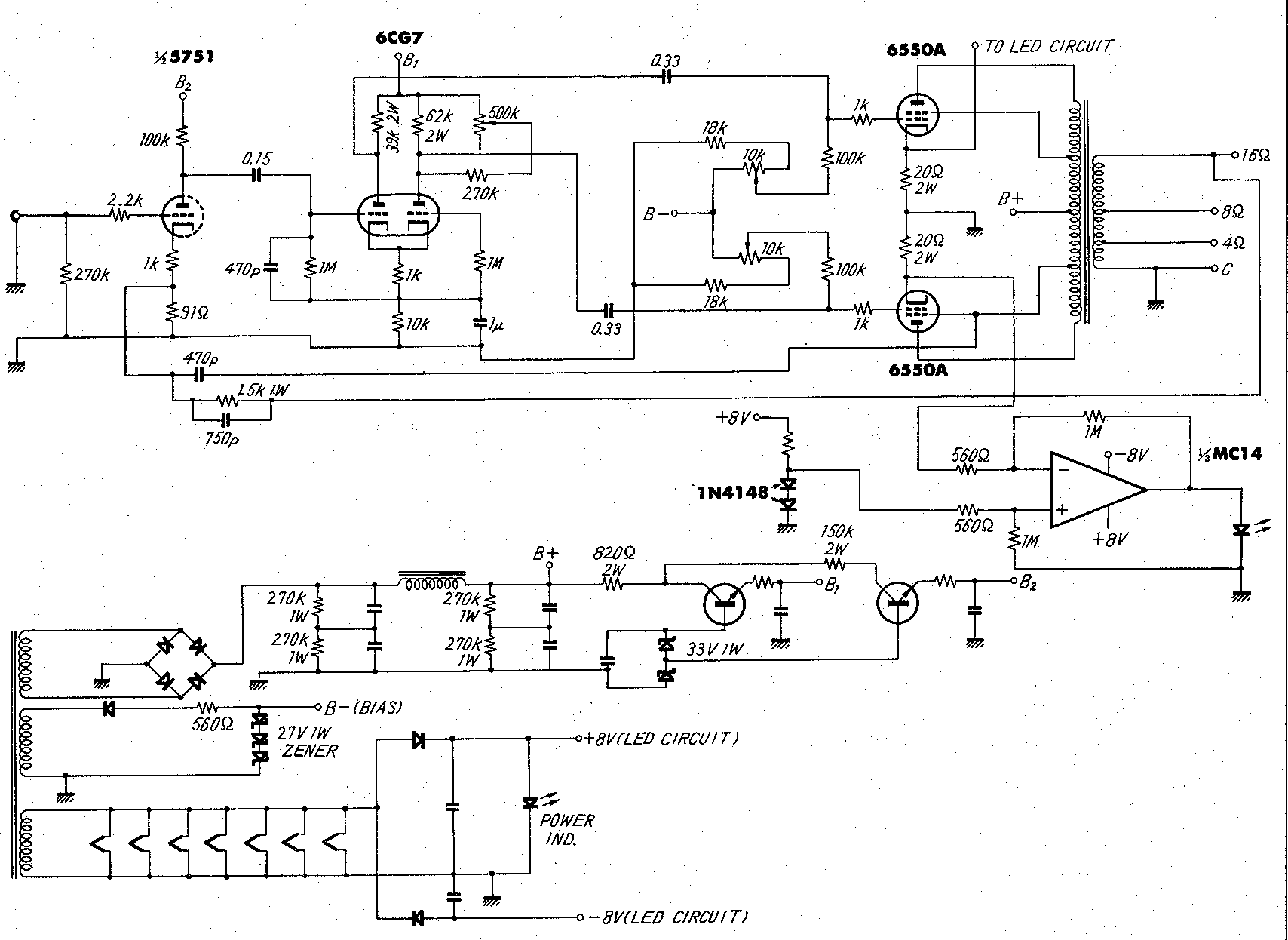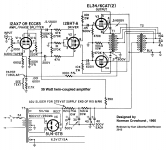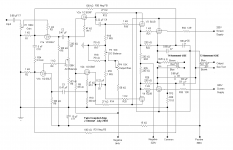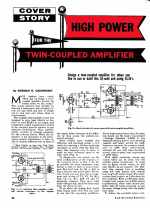... I just wanted to know if anyone has built a worthwhile tube amp yet and I don't see anyone who has done it DIY... maybe a little SE amp with 10 watts, but that's not going to do it for me. I'm looking to build the real deal.
What do you mean by "worthwhile tube amp"?
I'm not asking to pick a fight or argue, I'm looking for clarification and understanding. You've been talking about a MC240 clone, that's not impossible but there's going to be a challenge sourcing the output transformer. The reasons people don't clone McIntosh amps is the transformers. IF you can get them made, seriously, that's awesome, and I'd be interested in a pair myself.
I think now I want to look at SE and PushPull quality tube amp kits or quality instructions/schematics that are really good like the MC240 or better specs and sound quality.
Again, asking to clarify, you want a kit and not building it from scratch?
Then you start talking about a 20W SE amp here -
I think a really quality SE tube amp with 20 or more watts and super low distortion and great sound quality would be a good idea.
20W SE is a fairly tall order, but not impossible. "Super low distortion" and "tube single ended" do not live in the same universe. This not not to say that there are no 20W SE amps that sound good - there are plenty. But that's not a specification that will ever happen. "Low distortion" in SE amps is 1-5%. (Yes, people will argue with me, but it's not, overall, an in-genuine number.)
Or is there a recommended kit for a "more or less" MC240 or MC275 clone with the same or better performance (I like the +/-.1% db of the original MC240 and how it can handle almost any speaker.
In a word, no. There is no easy way to clone the MC amps and there are no kits.
From what you've asked/talked about you seem to be wanting an amp, tube output, SE or PP, 20+ watts output, preferably a kit, with the ability to drive somewhat difficult loads.
Is this correct?
EDIT: (Again for further clarification of mission and also to add some information)
Way back in post 1 you say;
I've asked about doing a MC240 clone and it seems like the transformers are too hard to DIY...
Yes, they are.
But more interestingly;
So, is it possible to do a CJ clone? How do their designs differ from the MC240?
Are the CJ transformer designs public information?
Ok, let's look -

(Image from here Conrad Johnson MV75 )
This is the c-j MV75, a very highly regarded amplifier and still sought after today. Speaking in broad generalities, it's a fairly classic tube amplifier layout, has a simple and effective voltage gain stage, followed by a differential amplifier ("long-tailed") phase splitter, has "fixed bias" (which is actually adjustable, because naming conventions are weird), uses KT88/6550 for good power connected to a completely standard (and easy to source) ultralinear transformer. The PSU is solid-state with a choke and voltage-referenced capacitance multipliers.
This is a very nice design and I'd happily consider it a candidate for cloning. Performance will be dictated mostly by how much money you're willing to spend on output transformers. If you get, for example, Electra-Prints, it's going to sound absolutely incredible.

Now let's delve into the MC240 a little -

Look at the output transformer. It's on the schematic where you'd expect it, as well as just below the output tubes.
It's got the "normal", primary windings, the "normal" secondaries, the specific to Mc designs cathode windings, AND a feedback winding. (14 filars in total, that's a LOT)
(and anode chokes, but those are separate...)
Now the circuit design itself is pretty unique as well, as there needs to be a lot of gain in the drivers to overcome the lack of gain in the output, as well as something specific to the design that has to do with feedback. I'm sure George can explain it much better than me. These two things do point to why it's not normally cloned, as we've already talked about - the transformers are difficult to source and probably won't be the right design, and the design is super complicated overall. BUT my experience IF the design is a very good performer and worth the bother, people will figure out a way. It speaks volumes that people don't clone it.
Copy of the Sam's Photofact of the MC240 - Box
Last edited:
mc240,
Take a look at the "stickys" at the top of the Tubes/Valves forum. There is one named "Safety Practices, General and Ultra-High Voltage", and another named "On Line Tube Learning for newbies...." .
If you read through those it may help you in your understanding of the subject.
Take a look at the "stickys" at the top of the Tubes/Valves forum. There is one named "Safety Practices, General and Ultra-High Voltage", and another named "On Line Tube Learning for newbies...." .
If you read through those it may help you in your understanding of the subject.
mc240,
Take a look at the "stickys" at the top of the Tubes/Valves forum. There is one named "Safety Practices, General and Ultra-High Voltage", and another named "On Line Tube Learning for newbies...." .
If you read through those it may help you in your understanding of the subject.
lol, the lab at college had it's two of it's own power grids, each the size of a city block, just for the lab. The lab is funded by the US dep of energy. You guys sound a little silly. It's not voltage that is dangerous, it's the amperage... even a tiny amperage can kill people, but they make kids toys out of 5000v plasma globes. I seriously just touched a raw wire 120v/15a and it was not something I want to repeat and could kill a weak person, I guess I was lucky but didn't die. However I don't any hi-fi amps have 15a going through them once the power transformer does the work. The power transformer probably ups the voltage and greatly decreases the 15a from the wall to something a lot safer. Again you guys sound silly and what I see is a bunch of people trying to sell stuff and posting links to their own companies or friends companies. You guys must see everyone coming on here as potential fresh meat to trick into buying your stuff.
Back to the topics if the OT from NL doesn't have the right wires, then I'll tell them to make one that has the right wires. Seems simple enough. It's not rocket science, but I could work for NASA if I wanted to.
And you guys kept saying that the OT are so expensive, since when is $200 euros expensive? You guys have to really read the stuff you type.

mc240 -
I'm putting on my moderator hat and suggesting that you very carefully and seriously take the voltage warnings that are being offered to you in good faith. You have an education in electronics, figure out how much energy these PSUs have at 500V stored in the caps and choke. These amps can bite hard if you're lucky, and have the potential to be easily (and quickly) lethal.
People here in this thread are very knowledgable and experienced in the making of building tube amplifiers. They are trying to help you, because this is what the forum is all about. We honestly want you to succeed.
If you make another comment with the tone being completely caviler about HV safety, I.E., about how this stuff is safe and I know what I'm doing, and you guys don't have a clue, don't worry, I've been shocked before, etc... I will close the thread.

Last edited:
Look it up, as I did.....it does not have the required cathode windings.
I'm not sure where you looked it up, but the VDV-1070-UC should be the same as the Plitron PAT-1070-UC (Both are the Vanderveen Unity-Coupled transformer made by different companies). They should both have bifilar primaries with plate and cathode windings.
Wherever you looked it up probably gave you bad info.
The earlier link in this thread (post 53) gives this:
Specialist: VDV-1070-UC-PPS
and the page 2 pdf there gives this:
https://www.mennovanderveen.nl/cms/...PS/2018-11-09_VDV-1070-UC-PPS_datasheet-2.pdf
Seems to be showing two screen windings instead of the cathode winding. Maybe it works as either? Would be a different primary Z for the two cases. I think the pdf has the wrong diagram or is labeled incorrectly.
Specialist: VDV-1070-UC-PPS
and the page 2 pdf there gives this:
https://www.mennovanderveen.nl/cms/...PS/2018-11-09_VDV-1070-UC-PPS_datasheet-2.pdf
Seems to be showing two screen windings instead of the cathode winding. Maybe it works as either? Would be a different primary Z for the two cases. I think the pdf has the wrong diagram or is labeled incorrectly.
Last edited:
Now you told us your qualification. You had been a no name avatar with no location, country nor qualifications, and you may as well turn out to be the actual legitimate emperor of China.... I ... have a Physics degree from a top 20 university, I'm the CEO of more than one scientific company, I helped record my first album at age 10 or 11, I've been playing with the big toys since I was a kid. ... nothing I didn't already know in 1993.
Forgive us Your Royal Highness, perhaps I could interest Your Royal Highness to help President Trump a little bit by starting a DIY friendly transformer shop in the good old US of A? You seem to possess qualifications much higher than any transformer maker that we know of worldwide. Let me contribute to the great effort by placing a firm order of 4 (four) pieces of MC240 transformers. Kindly have pity on our limited resources we can draw from and charge us no more than US$ 54 for a 50% profit from your firm claim of a US$ 36 cost of production. 6L6 also mentioned an interest to acquire 2 (two) pieces. I and 6L6 will promote the DIY friendly transformer shop here in our lowly DIYAudio forum and every other way we can think of as soon as Your Royal Highness notify us that the great effort has been put in motion.Ok, I looked up the "Monolith Magnetics"... those kind of shops charge a lot for something that costs them a little, definitely not DIY friendly. The best place to get cheaper transformers is from a place like this, since in my previous post I've shown where a unity coupled transformer to the original McIntosh specs cost just $36 to build DIY. ...
Last edited:
Some Twin Coupled Amps for reference:
1) Norman Crowhurst's 2nd version with EL34
2) J Stewart's Twin Coupled version with 6LU8
3) article on N. Crowhurst Twin Coupled
DIY: EL34 Twin Coupled Stereo Tube Amplifier - Stellar Vintage Electronics of California
1) Norman Crowhurst's 2nd version with EL34
2) J Stewart's Twin Coupled version with 6LU8
3) article on N. Crowhurst Twin Coupled
DIY: EL34 Twin Coupled Stereo Tube Amplifier - Stellar Vintage Electronics of California
Attachments
Last edited:
I've been doodling a little here and unless I've made a mistake it looks like with a pair of 100W 2.5k:8 transformers and a pair of 813s, it would be simple to get 200W out of a Twin-Coupled arrangement. That'd be a pretty cool amp.
I mean, I'll probably never make an amp with big transmitter tubes but if I did, that's how I'd do it.
Directly heated tubes like the 813 and Unity Coupling won't correspond, I think. Not to speak of the very high plate voltages you'd need to find enamelled wire for.
Best regards!
Still think that best way to get similar power & bandwidth wise results as Mac 3500/MI350 is to use three or four pair of TV sweep power tubes (PL519/PL509) in Circlotron configuration biased very close to class B ,
where anode B+ can be in order around 450VDC and G2+ around 170VDC ,
and where output transformer can be configured also as simple autoformer with no any high DC voltage present inside the bobbin.
where anode B+ can be in order around 450VDC and G2+ around 170VDC ,
and where output transformer can be configured also as simple autoformer with no any high DC voltage present inside the bobbin.
The earlier link in this thread (post 53) gives this:
Specialist: VDV-1070-UC-PPS
and the page 2 pdf there gives this:
https://www.mennovanderveen.nl/cms/...PS/2018-11-09_VDV-1070-UC-PPS_datasheet-2.pdf
Seems to be showing two screen windings instead of the cathode winding. Maybe it works as either? Would be a different primary Z for the two cases. I think the pdf has the wrong diagram or is labeled incorrectly.
Yes, because:
1. "UC" in the part # indicates it is a Unity Coupled transformer, it has to have a cathode winding to be a Unity-Coupled transformer.
2. Many of the parameters are extremely similar to the Plitron 1070-UC datasheet.
It is a mislabeled datasheet, which doesn't inspire confidence.
Last edited:
I wish I had your patience......they just ran out.
I lost my cool last night, shut the PC off and walked away. I will not invest any more time in someone who is convinced that we are all just "people trying to sell stuff and posting links to their own companies or friends companies. You guys must see everyone coming on here as potential fresh meat to trick into buying your stuff." I only sell my PC boards, and he already stated somewhere in one of his threads that you can't build a good amp with a PC board.
I must however state some facts related to electrical safety for the benefit of other readers who may not understand what the concerns are.
You guys sound a little silly. It's not voltage that is dangerous, it's the amperage... even a tiny amperage can kill people
This is a TRUE statement. A small current can disrupt the nervous system of a human or other living being, and cause death due to cardiac arrest. The amount of current that can cause damage or death varies from person to person, and where it passes through the body.
A large current (amps) passing through one finger to another finger on the same hand could blow a finger or two off the hand without killing the recipient.
A much smaller current of a few milliamps passing through the chest cavity of a human could cause cardiac arrhythmia or death.
The skin of a human has a relatively high resistance compared to the internal tissue and the blood vessels. Once inside the outer skin the body's internal resistance is quite low, and again variable from person to person.
However I don't any hi-fi amps have 15a going through them once the power transformer does the work. The power transformer probably ups the voltage and greatly decreases the 15a from the wall to something a lot safer
This is where things go VERY WRONG, as basic ohms law will reveal.
True the maximum rated current from a house power outlet in the USA is 15 amps. The short circuit current from that same outlet in the time before the breaker trips can be well over 100 amps, and well over 20 amps can be drawn for several minutes before the breaker trips.
A well designed tube amp capable of producing 50 watts per channel will need from 300 to 500 watts of power from the outlet. If it is properly fused for safety it may have a 5 or 6 amp slow blow fuse. The power transformer in this tube amp will step up the 120 volts to something in the 300 - 400 volt range, and once rectified and filtered be 400 to 500 volts DC for a typical 50 WPC tube amp.
Assuming a 5 amp fuse on 120 volts, the imput from the power outlet could be 600 watts forever without blowing a fuse. 600 watts at 500 volts is 1.2 amps! So yes, the power transformer in the tube amp has increased the 120 volt line voltage to 500 volts DC, and reduced the continuous current capability from "15 amps" to 1.2 amps.
This 500 volt power supply may be rated for 300 to 500 milliamps in normal operation. It will have several hundred microfarads of filter capacitance, all of which contain unfused stored energy......that 1/2 CV squared thing from physics class.
If an unusually low resistance were to be applied across this power supply all of that stored energy would be instantly released into that low resistance. Once that is exhausted, the internal resistances in the power transformer and other parts would limit the fault current to something in the 5 AMP range until the fuse blew. If the current is 1.2 amps or less, the fuse would not blow until some other component failed causing the fuse to blow.
What happens if a human gets connected to that power supply?
The skin resistance of a human varies a lot from person to person, and within the same person depending on conditions. Cold dry skin can have 20 K ohms of contact resistance, while hot sweaty skin can be in the 1 to 5 K ohm range or lower.
So if a cold dry human (20K ohm) gets connected across the 120 volt 15 amp line voltage he could get a 6 milliamp shock. Painful enough to cause a reaction, possibly serious if it passed through the chest cavity.
What happens if the same human gets connected to the 500 volt power supply. Now he gets a 25 milliamp shock from DC current which WILL cause involuntary muscle contraction, sometimes making it impossible to let go of the shocking object, and is enough current to KILL YOU! Note that this is a NORMAL OPERATING CURRENT for this power supply, so it sees no fault and will keep on producing that current forever.
What happens when someone like me who sweats a lot all the time, even in winter, touches that same power supply. Voltages above 300 or so volts (again varies by person) will blast a hole through that outer layer of skin creating a carbonized path of burnt flesh directly to that warm salty tissue beneath the surface. Now the resistance of the tissue is much lower and the fault current is much higher. Remember that stored energy, it is released first powering those big bass drum hits in your tube amp, or blasting that hole in your flesh deeper for more current, which can be in the 100 to 500 mA range......DEADLY. This is why the "safe" current in a tube amp can and will kill you dead!
It is said that DC voltages from 350 to 700 volts are often the most dangerous, because higher voltages cause such a violent muscle contraction that the subject often frees themselves from the current source.....I'm not going to test that statement....make sure that you don't either!
Directly heated tubes like the 813 and Unity Coupling won't correspond, I think. Not to speak of the very high plate voltages you'd need to find enamelled wire for.
Best regards!
Where there is a will, there's a way. My KT88 Unity-Coupled amp has separate floating heater windings for each tube, so could an 813 amp. Separate floating DC supplies are a possibility with some effort required. Switching supply would be my approach.
Also, if you go back and read my response to Chris, you will see that I was referring to a Twin-Coupled design which would not require special wire (although care should still be made to find transformers that could isolate 1kV+ primary-to-secondary).
I certainly wouldn't make such an amp, but maybe somebody like that guy Magz would. And if they did, I'm sure it could sport some impressive performance.
George, keep away from royalty. Worse are those who are not but figure everybody else should treat him like one. Remember all resulting medications we potentially need afterwards.I lost my cool last night, shut the PC off and walked away...
Remember all resulting medications we potentially need afterwards.
There is a button for these times.......oddly enough on a Windoze machine it says start......as in go start something else. Last night it was my soldering iron.
Judging from the level of maturity in some of these posts, I get the feeling we are talking to a 17 year-old who's father perhaps had a Mac amp...
Regardless, Making fun of, and ignoring safe electrical practices is utterly irresponsible!
Mods, this thread should be lost between the cracks.....
Regardless, Making fun of, and ignoring safe electrical practices is utterly irresponsible!
Mods, this thread should be lost between the cracks.....
In Glass Audio 3/99 Menno showed 8 variation of PP schematic of which the tranformer is being used. About circuit 4 he only wrote "I have not discussed circuit 4 because it is stable only under the special conditions as set by McIntosh, with a local feedback ratio equal to 1." and nothing else afterwards either. I think you need to manually add some windings for the CF or special order a set to use the 1070-UC for a true Unity Couple duty.Yes, because:...
- Status
- This old topic is closed. If you want to reopen this topic, contact a moderator using the "Report Post" button.
- Home
- Amplifiers
- Tubes / Valves
- DIY McIntosh Amp


